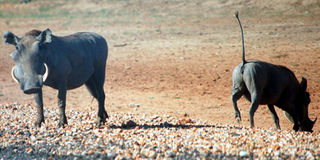Battle for Coast’s hidden gem

Photo/LABAN WALLOGA/NATION
The conservancy is home to a rich forest biodiversity with rare and endangered animals.
Tana River is sitting on a rich biodiversity and cultural heritage that if properly harnessed could generate billions of shillings from tourism.
The new county is arguably among those best-endowed with natural resources; yet it is among the poorest in the country.
At Kipini in the lower Tana, its huge potential may be among the county’s least known assets, with its soil rich delta and talk of oil exploration.
Kipini itself is a cosmopolitan town because of the many communities living side by side and scraping a living from agriculture and fishing.
But the indigenous Pokomo, Swahili, Arabs, Giriama, Sanye plus other communities from upcountry share high levels of poverty.
Straddling the vast hinterland of Tana River and Lamu counties and the delta where the Tana enters the sea is Kipini conservancy, a haven rich in unique flora and fauna.
It is one of the few corridors for large mammals such as elephant and buffalo, while it also boasts a huge diversity of marine life including dolphins, prawns and other fish and coral species.
Conservationists are warning there are now very few places remaining on the Coast with pristine habitats and abundant wildlife like Kipini because of land taken for property development.
A few areas are legally protected but these are inadequately managed due to a shortage of money.
Dr Omar Sherman, set up the Kipini Wildlife and Botanical Conservancy, on the 22,000 hectare Nairobi Ranch, which retains considerable environmental integrity.
The Sherman family (known locally as the Swaleh Nguru family) secured the land under a freehold arrangement and have maintained the area even at a loss.
Development of the ranch is necessary, they say, because Kenya can ill afford idle land, but it has to be done with regard to proper conservation.
“By creating an easement on this freehold land, we have put in trust this important resource for future generations of Kenyans and visitors to the country.
“But this will need vigorous management and will involve a rollover from the ranch system based on livestock to one of mixed species and botanical care.
“Income generation will be based on heritage value and donor support in the short term, with increasing reliance on eco-tourism,” said Dr Sherman.
But the Government and conservationists have expressed fears that the forest which houses the Kipini Wildlife Botanical Conservancy could be destroyed as squatters and trespassers have started clearing sections for cultivation.
The forest, formerly private property was acquired by the Government when the conservancy was declared a Provisional Forest by the Minister for Forestry and Wildlife through a legal notice under the Forest Act.
The Government took over control of the private conservancy and placed it under the management of Kenya Forest Service (KFS) to stop its degradation and restore its biodiversity.
According to the Forest Act, as a provisional forest the conservancy will be managed by the KFS and the owner Dr Sherman for a period of three years.
Once the KFS is satisfied that the forest has been sufficiently rehabilitated and the owner has undertaken to effectively manage it, then the ownership will revert.
Dr Sherman said the declaration followed consultations between KFS and the Kenya Wildlife Service. The conservancy is home to a rich forest biodiversity with rare and threatened species such as elephants, Hirola and leopards.
“The Kipini conservancy forms the remaining wildlife habitat corridor along the Kenyan Coast with a combination of beach, coastal forests and thickets found nowhere else in the country.
“The move to take over the forest was initiated following an invasion by illegal loggers and agricultural activities, overgrazing and rampant charcoal burning.
“Illegal human settlements had also started being developed thus interfering with the natural regeneration,” Dr Sherman said.
By the time of gazetting the conservancy by the Government, there were about 2,000 people working and living illegally in the forest.
Tana Delta DC Elias Githaura confirmed that some of the encroachers have been arrested by Kenya Forest Service officials.
“What they are doing is illegal and that is why they have to leave. Most of the people who have been living and clearing the forest are from the neighbouring villages in both Lamu and Tana Delta. They are clearing a Government forest and they have to move out,” Mr Githaura said.
According to the KFS, an estimated Sh23 million is needed as provisional budget to establish a forest station at the conservancy and undertake some of the rehabilitation works.
But one of those affected by the directive who spoke on condition of anonymity for fear of being victimized, said they were being intimidated when they had lived in the area for many years and even built permanent houses.




